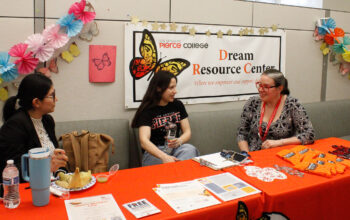The inverse relationship between college enrollment and the economy’s health has always been present, Transfer Center Director and Co-Chair of Enrollment Management Sunday Salter said. But now, as Pierce’s low-enrollment threatens the college’s financial stability, administrators’ wheels are turning.
“You have to think of it like a business, really. You have to keep things going even though we’re not for profit. We’re not looking to make money, but we’re certainly looking to keep things running,” Salter said.
Salters said funding cuts directly impact facilities, access to teaching materials, class schedules and availability.
“When we have fewer students here, we have to start closing sections of classes. That hurts students at the end of the day because there’s less availability in the time slots that they like,” Salter said. “Maybe they enrolled in a class that got cut right before the beginning of the semester, and now they’re scrambling. It’s just terrible. It’s not an outcome that anyone wants.”
Dean of Student Services William Marmolejo said enrollment concerns extend to the Los Angeles Community College District (LACCD) Office and beyond.
“We are struggling with enrollment district-wide, not just here at Pierce. In fact, it’s not just in the district, it’s up and down the state of California. We’ve seen the trend the last couple of years when we compare our enrollment from previous years,” Marmolejo said.
Marmolejo said students that remain are taking fewer classes, which further exacerbates the issue.
Salter said Pierce’s enrollment of non-traditional college students, ages 20-45, is decreasing.
“We’ve had zero percent decline in our high school enrollment. Those students have stayed consistent, if not grown, because of the College Promise program,” Salter said.
Salter attributes the former demographic’s low enrollment to the state’s robust economy.
“Typically, when the economy is in an upward trend and there are lots of employment opportunities, we see a decline like this,” Salter said. “If there’s a job, I’m going to work. If there’s not a job, I’ll retrain, I’ll go back to school and figure it out. I’ll change paths. That’s typically how the trends go.”
Marmolejo said it is important for students to remember how beneficial it is to have a degree, even in the face of immediate prosperity.
“The benefits of having even an associate’s degree, but especially a bachelor’s degree, can be very beneficial over a lifetime for your career,” Marmolejo said. “A million dollars is what I’ve heard someone who has a bachelor’s degree make over someone who doesn’t.”
Marmolejo said the college encourages its students to take a look at the long term perspective.
“In the short run, you can get a job 12, 13, 14 bucks an hour. But in the long run, if you have your BA, you can make 30-40 bucks an hour, as opposed to staying stagnant at that pay,” Marmolejo said.
Vice President of Student Services Earic Dixon-Peters said he and his peers are seeking solutions regardless of the macro-causes.
“I definitely think there is some funding, structural concerns statewide—looking at how we are measured in accountability measures, success measures—but before we go to the state to ask what we can get from them, we need to look at our own data and say what are the gaps and concerns and the areas we need to address,” Dixon-Peters said.
Dixon-Peters said Pierce needs to do whatever is within its financial means to overcome the enrollment hurdles.
“We can address these areas with our own budgetary alignment and focus on that,” Dixon-Peters said.
Dixon-Peters said his office’s Stop Out and Part Time survey, combined with the College Promise follow up questions, were designed to look at and create feasible solutions to increase the number of part-time students and full-time students.
Dixon-Peters said most students answered that they stopped attending college because of work. Two thirds said they were not full time because they have jobs.
“Then I asked how many jobs do we have on campus that are available for students, and when you look at our work study program, we only have 99 positions. So if I have approximately 13,000 students who are part-time, and two thirds say they are part-time because they have to work, and I only have 99 positions open for work study on campus. How can we be successful?” Dixon-Peters said.
Salter said the college is looking for ways it can improve its performance and attract students.
“If students are here and then they leave, is something wrong? Can we change our services, our courses, our environment or provide more support for students who are in need? We can help them meet their goals,” she said.
Salter said that low enrollment at Pierce is unrelated to students’ overall success.
“Transfer numbers are fine. Universities are still opening up their arms to transfers and increasing,” Salter said.




